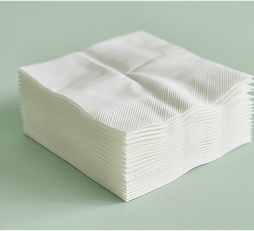How to Replace
Napkins
Discover reusable alternatives that clean better and never leave you scrambling to the store.

The Problem With Napkins
🎨Colored Napkins Release Concerning Chemicals
- A European Commission study found that almost half of colored napkins released Primary Aromatic Amines (PAAs), with many of these chemicals considered potentially harmful to human health.
- Research revealed that brightly colored napkins, especially red, yellow, orange, and multi-colored ones, released the highest levels of these chemicals when they came into contact with food.
- The German Federal Institute for Risk Assessment specifically recommends not using colored napkins to store or wrap food, particularly cake slices and other direct-contact items.
⚗️Bleaching Process Leaves Chemical Residues
- The chlorine bleaching process used to make napkins bright white can create dioxin compounds that remain in the final product, which are persistent environmental pollutants.
- Paper napkins often contain optical brighteners, wet-strength additives, and antimicrobial agents that can pose concerns when they come into contact with food or skin.
- Health experts recommend choosing unbleached or chlorine-free napkins to minimize exposure to chemical residues, though these are often harder to find and more expensive.
💰Hidden Costs Add Up Quickly
- Cost analysis shows that a family of four using paper napkins spends between $160-640 over two years, while a set of cloth napkins costs much less and lasts for years.
- The Sierra Club calculates that a family of four eating three meals daily uses 4,380 paper napkins per year—a number most families never consider when buying “cheap” paper products.
- Even higher-quality cloth napkins at $5 each quickly pay for themselves compared to constantly buying paper napkins, especially when they last for years.
🗑️Teaching Kids Wasteful Habits
- Once soiled with food, paper napkins can’t be recycled and must go to landfills, teaching children that single-use items are normal and acceptable.
- Parents know that children often tear apart paper napkins during meals, creating more waste and mess under the table—a problem that doesn’t exist with cloth napkins.
- Paper products make up about 25% of all landfill waste, meaning daily napkin choices contribute significantly to the environmental problems our children will inherit.
This content is for informational purposes only and is not professional advice. Always do your own research before making decisions. No guarantees are made regarding accuracy or outcomes.
Top Picks